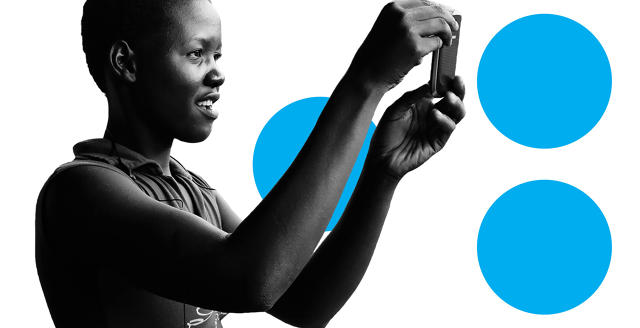The Ammunition-backed microlending startup Branch is a great study in how to design user experiences for the developing world.
About a year ago, Matt Rolandson, partner at the design firm Ammunition was driving his car through San Francisco on his way to work when he saw Matt Flannery, cofounder of the microlending nonprofit Kiva.org, striding by with seeming excitement. Rolandson rolled down his window and asked where Flannery was off to. "I'm off to start a bank in Kenya!" Flannery said. Without hearing anything else, Rolandson told Flannery to stop by the offices when he had a chance, to see if there was anything Ammunition could do to help.
In the end, Ammunition did more than help Flannery's new for-profit microlending business, Branch. They incubated it and became its first investors.

Today, Branch has 100,000 users in Kenya and Tanzania (where credit cards are not the norm), and they use the app to borrow small amounts, usually between $30 and $40. The loans are handed out based upon a machine-learning algorithm that scans users' data (with their permission), then approves or denies loans based upon what it finds. For example, Branch might scan a borrower's history and extrapolate that they can pay back a loan based on a high volume of calls versus text messages. When a loan is approved, the app works like a credit card, using Tanzania and Kenya's popular mobile wallet service, M-Pesa.
Though Branch may be designed with customers in Kenya and Tanzania in mind, the design principles behind the app can be applied to any developing country where mobile phone technology hasn't caught up to that of the first world. With the new version of the app released this month, Rolandson and Flannery sat down with us to talk about what lessons can be gleaned by other developers looking to design a new app product for the developing world.

Make It Small
In the United States and other developed countries, bandwidth is not that much of a design concern, thanks to the ubiquity of fast fiber, Wi-Fi, and LTE. Consequently, even simple apps usually clock in anywhere from 50 MB to 100 MB or more, including Facebook Messenger, Inbox by Google, Skype, and Twitter. We don't even think of these apps as bloated, but to someone in Tanzania or Kenya, they are. "These are countries where people usually pay for every megabyte they download," Flannery says. "So if you want people to use their app, it has to be as small as possible."
In Branch's case, Ammunition was able to reduce the size of the Android app down to just 2.7 MB, by keeping flashy graphics and custom animations to a minimum, and relying heavily on fonts that already ship on your phone.

Build For Cheap Phones First
While most people's cell plans in Tanzania and Kenya are quite expensive, the phones themselves are cheap. How cheap? "Really cheap," says Flannery. "Like, cheap Chinese Android phones that cost less than $50." That means they have small processors, little memory, and tiny screens. And forget about iPhones. "The only people who have iPhones are government officials, who don't need microloans."
So when it came to designing the Branch app, Ammunition took pains to make it as efficient on slow Android phones as possible, while also taking into account the fact that most people would be using it on sub-four-inch displays. System-choking animations are kept to a minimum, and while the graphic design is slick, it's visually simple. It also takes pains to keep the amount of text and actions per screen to the barest minimum—typically only one action per screen.

One Screen, One Action
"For our user base, Branch is probably the third app they've ever used, the first two being Whatsapp and Facebook, which usually come pre-installed on their phones," Flannery says. "Maybe if you're lucky, someone's used Twitter, too."
What that means is that general literacy of mobile UIs in Tanzania and Kenya is still at the level of the average American when Steve Jobs unveiled the original iPhone in 2007: nonexistent. That's why Ammunition took a step-by-step, one-action-per-screen approach to the majority of Branch's UI. It's a straight arrow, guiding users who may have never used a more complicated app through the process of signing up for their first loan.

Chat, Chat, Chat
Notice anything about the list of apps above? Whatsapp, Facebook, Twitter—they're all, in essence, chat apps. Because of the aforementioned pay-per-megabyte nature of African mobile carriers, the most popular apps are all about messaging and socializing: text, after all, is cheap in data terms.
Branch also has a chatting component through a "Get Answers" option which gives new users a familiar touchstone to get their head around a very different kind of app compared with the ones they're used to. But chatting solves an even more important secondary issue for Branch: trust.
"When people in these countries hear about Branch, their first thought is, this has to be scam, it's too good to be true," says Rolandson. The chat interface allows Branch users, skeptical of a service the likes of which we take for granted, to talk to a human and assure themselves it is real. Flannery says that they often get incredulous new users asking them to "prove" Branch is real. Chatting to a human helps them do that. "Chat's the real secret to our success," says Flannery.
Conclusion
Ultimately, what Rolandson and Flannery both think has been key to their success is delivering a modern, high-end looking app, to a part of the world that generally doesn't see many of them. "Really, all we're doing is bringing U.S. best practices to a market that isn't there yet," Rolandson explains. The slick designs that work in America can still be effective in other parts of the world, as long as you're not naive about the on-the-ground realities of the developing world. Meet users where they are, and you've won half the battle.